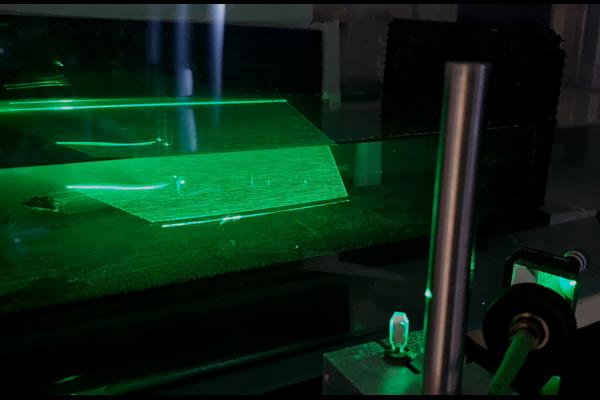- Share
- Share on Facebook
- Share on X
- Share on LinkedIn
Recruitment

Funded thesis offer 2025-2028
Supervision: A. Dupont (LIPhy)
Co-supervision: H. Djeridi (LEGI) & P. Peyla (LIPhy)
Context
Collective movements are a fascinating phenomenon, from human crowds to gigantic schools of sardines. In our team, we are interested in schools of fish, seeking to take into account the complexity of the interactions involved: social interactions [1,2], essentially visual, and hydrodynamic interactions, which are still poorly understood. We know that fish can sense hydrodynamic signals thanks to a specific organ, the lateral line. But while several studies have shown that it is possible to measure fluid flow around a single fish, there is currently a lack of experimental hydrodynamic data to characterize flow around a group of fish.
Thesis project
The project consists in carrying out an experimental study of the hydrodynamic wake of a group of fish, identifying and analyzing the dynamics of the vortices created by an individual fish at first, then by several fish, and following them as they interact with the flow produced by the other swimmers. Obtaining a time-resolved mapping of the flow within a small group of fish would represent not only a methodological achievement in the field of hydrodynamics, but also a breakthrough in understanding the role of hydrodynamics in school organization. The team created an initial set-up (see Figure) which validated the feasibility of the project. As part of the thesis, we will be collaborating with H. Djeridi's team (LEGI), specialists in this type of measurement (Particle Image Velocimetry, PIV), to set up a high-performance PIV device adapted to the study of the swimming behavior of a group of fish. The aim will be to carry out experiments PIV analysis to measure fluid flow within a group of living fish under controlled conditions. This experimental study will benefit from the contribution of numerical simulations of fish shoals carried out as part of another project [3] between LIPhy (P. Peyla) and INRIA (T. Métivet). These will enable us to extract relevant quantities for interpreting fish biomechanics and perception.
Candidate profile
The PhD student will have a solid basis in fluid mechanics and an interest in the physics of living systems. The project requires a taste for instrumentation and experiments.
More info
The thesis will take place at the Laboratoire Interdisciplinaire de Physique (LIPhy) in Grenoble (France), where research topics range from soft matter to optics, the physics of life and complex matter, with experimental and theoretical approaches. Many doctoral and post-doctoral students work here, organizing seminars and events among themselves. The thesis will benefit from collaboration with the Geophysical and Industrial Flow Laboratory (LEGI), located on the same campus and specializing in fluid mechanics.
References
[1] Larrieu R., Moreau P., Graff C., Peyla P., Dupont A. Scientific Reports. 13, 10414 (2023)
[2] Ventéjou B., Magniez- -Papillon I., Bertin E., Peyla P., Dupont A. Physical Review E 109, 064403 (2024)
[3] Ventéjou B., Métivet T., Dupont A., Peyla P. Physical Review Letters 134 (13), 134002 (2025)
Download
OffreThese_poissons_EN.pdf (PDF, 222.85 KB)
Contact
Aurélie Dupont
OPTIMA team
aurelie.dupont univ-grenoble-alpes.fr (aurelie[dot]dupont[at]univ-grenoble-alpes[dot]fr)
univ-grenoble-alpes.fr (aurelie[dot]dupont[at]univ-grenoble-alpes[dot]fr)
Personal webpage
- Share
- Share on Facebook
- Share on X
- Share on LinkedIn